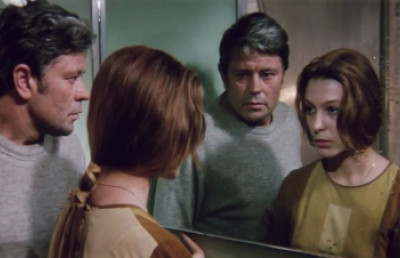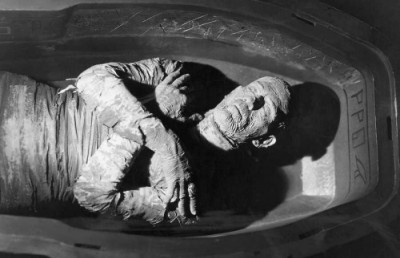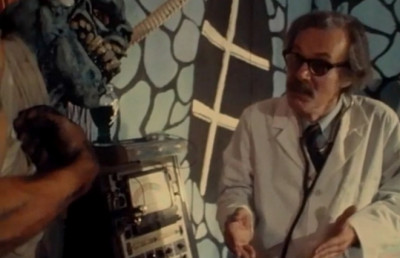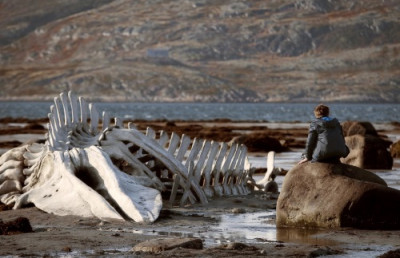The Neutral, Onirosigns and Any-Body-Whatevers in Nostalghia
On the rhythm of any-space-whatever in Andrei Tarkovsky’s Nostalghia
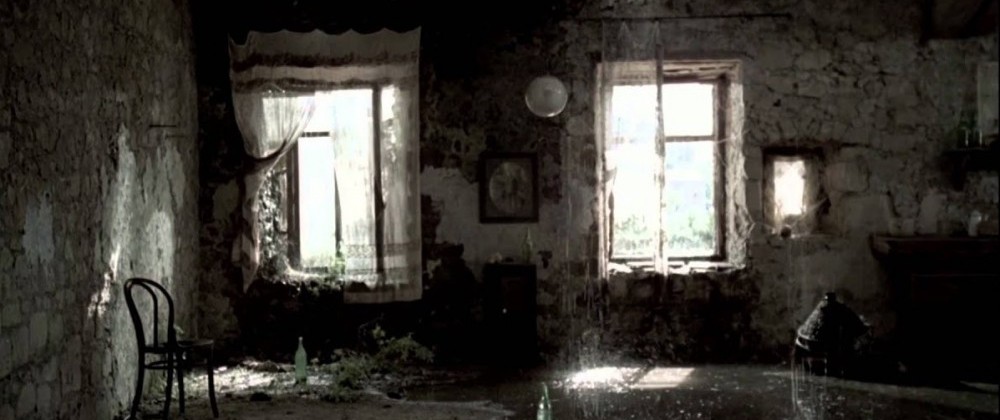
Abstract:
This article examines if particular any-space-whatever rhythms can be discerned in Andrei Tarkovsky’s Nostalghia (1983), how these rhythms function specifically, and what consequences they have for the extension and/or better understanding of the concept of any-space-whatever (Deleuze). First and foremost, this article should be considered as a playful exercise in or attempt at concept creation, concept specification, concept elucidation (or, for that matter, needless concept complexification); a zooming in on the diverse facets of any-space-whatever. My analysis will show that in Nostalghia, any-space-whatever functions as a territorial motif; all motifs combined form the any-space-whatever territory. There are three types. The first type is the Neutral (Barthes), the progressive accentuation of affective intensities (micro-rhythms). Here, the world isn’t framed by movement, but movement itself frames the world by virtue of the camera tracking through space, allotting different accents underway. The second type is the dream-image, which constitutes a double any-space-whatever rhythm: that of the dream-image, which shatters the sensory-motor scheme from the inside, plus the rhythm of the Neutral. The third type is the any-face-whatever, or any-body-whatever: characters who become any-space-whatever themselves by virtue of being little more than the rhythm of their faces or bodies. This abstract may be a little dense, but don’t worry: all concepts will be explained in due time and, hopefully, with due diligence.
1. Any-space-whateverIn his film-theoretical book Sculpting in Time (1987), Andrei Tarkovsky expresses his dislike for Sergei Eisenstein’s intellectual montage dictum, in which every cut, every new mise-en-scène is supposed to mean something, express an idea, make a point, hides an abstract subtext that needs to be unraveled (24). According to Tarkovsky, Eisenstein turns the film image into a hieroglyph in which there isn’t ‘a single detail that is not permeated with the author’s intent’ (67). The result: a ‘total onslaught on the audience’, a continual imposing of the director’s own view – on the viewer – on what is happening, which, Tarkovsky judges, ‘leaves no air, nothing of that unspoken elusiveness which is perhaps the most captivating quality of all art, and which makes it possible for an individual to relate to a film’ (118 & 183).
Gilles Deleuze seems to share a similar opinion. He is wary of regarding film images as ‘lectosigns’, i.e. as images that should be read or seen as something different from what they explicitly or inexplicitly communicate or do not communicate to the viewer (Cinema 2 24). The fact that Deleuze describes cinema as ‘pure semiotics’, does not mean that every cinematic image means something beyond its particular sign (C2 137). Everything that happens on screen may be liable for classification, but there is no special understanding beyond the classification; Deleuze’s codification is a mere ‘system of images and signs independent of language in general’ (C2 29). The problem with regarding an image as a text lies, according to Deleuze, in the notion that ‘at the very point that the image is replaced by an utterance, the image is given a false appearance, and its most authentically visible characteristic, movement, is taken away from it’ (C2 27).
The image, then, which seems to have no false appearance whatsoever, which seems to contain pure, unadulterated movement, which is rampant with unspoken elusiveness and which cannot be clothed in false utterances or false appearances, might be the purest – or the least impure – of all cinematic images. This is where Deleuze’s concept of ‘any-space-whatever’ (‘espace quelconque’) comes in. What is any-space-whatever? 1 Deleuze introduces the concept as follows, in Cinema 1: The Movement-Image (1983):
Any-space-whatever is not an abstract universal, in all times, in all places. It is a perfectly singular space, which has merely lost its homogeneity, that is, the principle of its metric relations or the connection of its own parts, so that the linkages can be made in an infinite number of ways. It is a space of virtual conjunction, grasped as pure locus of the possible. (C1 109)
This defining introduction is followed by the following sentence: ‘What in fact manifests the instability, the heterogeneity, the absence of link of such a space, is a richness in potentials or singularities which are, as it were, prior conditions of all actualisation, all determination’ (C1 109). If a character expresses an emotion, if he or she present his- or herself in a state that we can determine as being emotive, the image becomes what Deleuze calls an ‘affection-image’. Any-space-whatever should be considered the genetic element of the affection-image: a potentiality, or a ‘before’ (C1 110). A character that establishes a certain blankness by virtue of not expressing an emotion or undertaking an action, constitutes a disconnected space charged with potential; he or she becomes a ‘seer’, a being who sees rather than acts. This is the first form of any-space-whatever. The second form is the first form taken to the extreme: not mere disconnection but emptiness, an ‘after’. Event, character and action disappear from the image; they are being hung out to dry, so to speak, in a void (C1 120 & C2 xi). Even though Deleuze distinguishes two forms of any-space-whatever, he emphasizes that the phenomenon’s nature remains one and the same: namely that of an uncoordinated, pure potential, that shows ‘only pure Powers and Qualities, independently of the states of things or milieux which actualise them’ (C1 120).
In Cinema 2: The Time-Image (1985), Deleuze offers supplementary observations regarding any-space-whatever and typifies it as a situation we no longer know how to react to, a space we no longer know how to describe (C2 xi). The crisis of the ‘action-image’ – briefly put: an image that features a clearly motivated deed by a character, a movement towards a goal – loosens the ‘sensory-motor linkage’ (the motivational scheme) and subsequently presents the viewer a little moment of time in a pure state, independent of action (C1 65; C2 xi). What the any-space-whatever confronts us with is a pure optical and sound situation that indexes nothing, because it has no material links outside of itself: it exists on its own and for its own sake (C2 6).
Deleuze seems to have been the first to elaborately describe – in both Cinema books – the partiality in modern cinema (European cinema post-World War II) for spaces that are no longer determined. The academic discourse on what I would like to call, in an umbrella term sense, autonomous cinematic space, is longstanding though. Aside from Deleuze, the most important contributors to this discourse are the following. Béla Balázs calls moments that feature events without context or causality, ‘absolute film’ (Balázs 159-161). Noël Burch calls suspensions of diegetic flow ‘pillow-shots’ (Burch 160). Seymour Chatman calls the moment space becomes the scene itself ‘temps mort’ (Chatman 126). Gilberto Perez calls an accent on empty space ‘thin air’ (Perez 136), and Timotheus Vermeulen and Gry C. Rustad – they focus on television predominantly though – call the lingering of the camera in a space longer than is necessary for the development of the plot, the ‘late cut’ (Vermeulen & Rustad 3-4). The most important difference between the concepts of abovementioned theoreticians and Deleuze’s any-space-whatever concept resides in the circumstance that in Deleuze’s conception, autonomous space isn’t encoded with significance or meaning that can or should be decoded a posteriori. Any-space-whatever is a potentiality without additions. Balázs, Burch, Chatman less than others, Perez, and Vermeulen and Rustad all tick off, in varying degrees, possibilities they read in the potential. They seem to regard autonomous cinematic space as something that carries the seeds of actualization, seeds that they harvest themselves through textualization, that is to say: through interpretation, meaning attribution, translation et cetera.
Leaving interpretation aside, what every cinematic space offers, always and unambiguously, is its own particular rhythm. Since cinema is an audiovisual art that takes place within elapsed time, the immediate perception of a rhythmic shift to or the rhythmic dimension of autonomous cinematic space seems to be just as imperative as its limitless interpretive potentials – if not of more significance. Meaning, interpretation (beyond categorizing something as any-space-whatever), translation, or what the semiotic sign of any-space-whatever signifies beyond its semiotic sign, are of no interest to me. My sole interest lies in the rhythm of the semiotic sign, because I believe rhythm to be one of cinema’s most authoritative aspects.
2: Rhythm
In his The Aesthetics and Psychology of the Cinema (1963), Jean Mitry notes that rhythm in general is nothing more than the dynamic extension in time of perceptual forms (121). Now, if rhythm is nothing more than the dynamic extension in time of perceptual forms – which is precisely what a film is – then the impression of the film as a whole is the impression of its rhythm. Essentially, a film is nothing but a delimited rhythm, or, to put another spin on it, with a slight nod towards Deleuze and Guattari, though without using the word in the particular sense in which they use it: a rhythm territory. A film: a congregation of rhythms, assembled within time; thus a territory in the simplest sense of the word, ruled sovereign by rhythm. In its totality a film can be considered as one single rhythm. This single rhythm can be subdivided into a vast amount of macro- and micro-rhythms (I will explain these shortly), color rhythms, spatial rhythms, rhythms within rhythms, the rhythm of any-space-whatever et cetera, which, once again, all combined on their turn constitute the individual rhythm of the film. This is the main reason why rhythm could be considered cinema’s most democratic element – and perhaps the most authoritative at the same time, since it is all-pervasive. Undoubtedly, some rhythms draw more attention to themselves than others, for instance by virtue of an intense contrast between one shot and the next. But a hierarchy of importance is difficult to imagine, because the (discrete) rhythm of the eighth minute is just as influential for the impression of the whole, as the (intense) rhythm of the 80th minute. Regardless of the quality and the quantity, every single rhythm shapes the impression of the whole in equal amounts. This is why I would like to observe that rhythm is the discourse of form. 2 It governs everything, but it does so without language.
So, what does cinematic rhythm consist of, or perhaps more adequately put: what are the methods with which we can make rhythm concrete? Danijela Kulezic-Wilson, in her book The Musicality of Narrative Film (2015), distinguishes two main rhythm categories: ‘external rhythm’ and ‘internal rhythm’ (59). 3 Since editing, or the cut, is imposed externally upon what is happening on the screen, all editing shapes or more adequately put is the film’s external rhythm. Everything that happens and is visible between two cuts, the organization of the mise-en-scène, lighting, color, movement et cetera, forms the internal rhythm (59). Indeed, one could state rather bluntly that within the film image (excluding independent peripheral factors that influence the consumption of the film and thus contribute to the impression of its rhythm, i.e. the projector speed, the location where the film is exhibited, the organization of the public, the mood of the viewer et cetera) nothing exists outside of external and internal rhythm.
The external and internal rhythm categories can be subdivided into macro-rhythm and micro-rhythm categories, 4 which, on their turn, can both be subdivided into – or are made up out of – the rhythm elements I will enumerate below. Note that the following terms come from an online interactive textbook that was designed to support the ‘Art, Design, and Visual Thinking’ course, taught at Cornell University and authored by Charlotte Jirousek (1995: http://char.txa.cornell.edu/language/principl/rhythm/rhythm.htm), but the particular subdivision of those terms within the macro- and micro-rhythm categories is mine. I would like to subdivide macro-rhythm, i.e. the formal organization of the whole, the accents that form the structure and the cohesive unitization of the film (Kulezic-Wilson 65-67), into these four categories: repetition (of an editing pattern for instance); alternation (for instance between dream-images and reality); gradation (in a tragedy: things going worse and worse until the ultimate downfall); and unity (of concept for instance). And I would like to subdivide micro-rhythm into these four categories: emphasis; interruption; contrast (between anything: color, shape, movement, texture, et cetera); and shifts in focalization – in short: practically everything that shows an alteration between one particular element (which can be anything) and what immediately precedes or follows it.
With these methods, I want to explore if particular any-space-whatever rhythms can be discerned in Nostalghia, how these rhythms function specifically, and what consequences they have for the extension and/or better understanding of the concept of any-space-whatever. Such an analysis captures three important things: a) it questions the existence of any-space-whatever in Nostalghia (which cannot be considered an a priori fact); b) how rhythm functions within the film’s any-space-whatever(s) – if existing; and c) what those specific rhythms enlighten about the concept of any-space-whatever. Note that steps a and b aren’t necessarily consecutive. Moreover, they take place simultaneously: what pronounces itself as any-space-whatever does so by virtue of its particular rhythm.
3: The NeutralTarkovsky writes, again in Sculpting in Time: ‘Editing brings together shots which are already filled with time, and organises the unified, living structure inherent in the film; and the time that pulsates through the blood vessels of the film, making it alive, is of varying rhythmic pressure’ (114). Nostalghia’s ‘living structure’ seems to be governed by a macro-rhythmic network of long takes, slow and serene camera movement (at times extra heightened through the use of slow-motion) and the interspersion of dream-images. These macro-rhythms, in concurrence with the three territorial any-space-whatever motifs – the Neutral, onirosigns and any-face-whatevers or any-body-whatevers – I will elucidate these concepts in the following paragraphs – establish a decidedly singular mood. In Nostalghia, the camera doesn’t merely register, it creates mood by virtue of the employment of what seem to be highly individual external and internal rhythms. The film’s internal rhythm, dominated by desaturated coloring, frequently underexposed places, sums of empty space and slow camera movements that gain in poignancy through the fact that the characters in the frame discharge a certain stillness, seems to attain a quality of concentration so particular, that the general mood almost seems feverish in nature. I do not mean that negatively in any way whatsoever, but rather metaphorically – in the sense of a fever-induced heightened awareness. Concentration is divulged by placing the viewer in a passive position, a passivity accomplished by the fact that the camera frequently is underway – to what the viewer doesn’t know –; that the camera moves through the same space the characters on screen move through, paying as much attention to the space as to the characters; and by Tarkovsky’s tendency to place the goal of the scene at the very end of it, thereby allocating everything that comes before it as a form of ‘progressive accentuation’(Barthes qtd. in Seigworth & Gregg 10), a sort of ‘sculpting in time’ indeed, by which the sculpted image only at the very end becomes entirely visible.
The first of two sequences that comprise Domenico’s monologue on top of the statue of Marcus Aurelius, at Capitoline Hill, Rome, opens at 1.42.45 minutes into the film with a close-up of two men, one with his face towards the camera, the other with his face turned away from the camera. The camera proceeds to track slowly to the left, to eventually reveal occupied stairs in a long shot (upper two frames of Figure 1). During this shot, only two seconds short of 1 minute and 30 seconds, we hear Domenico deliver the first part of his monologue, but we do not know where he is located precisely. At 1.44.13, after the cut, we finally get to see him in a medium shot. The camera proceeds to slowly zoom out to a long shot, revealing his position on top of the statue of Marcus Aurelius (lower two frames of Figure 1).
At 1.45.37, Tarkovsky cuts to the next scene. Note that in both shots that comprise the first sequence of Domenico’s monologue, the viewer is placed in a somewhat passive position from the outset. Only gradually and slowly the space wherein the action is taking place is revealed, once by a tracking shot that progressively results in a long shot, and once by a zoom out that predictably ends in another long shot. (A passive position I say, but one could also judge it an active position by virtue of the inquisitiveness this passivity instills in the viewer.) Only after the short sequence in Bagno Vignoni, which comes after the above described sequence and in which Gorchakov readies himself to bring the lighted candle across the emptied thermal bath – also the first of two sequences that comprise one event – the camera cuts back to Domenico. Domenico’s death marks the end of the sequence (a long shot of his burning body), but Gorchakov’s lighting of the candle (a close-up of his hands), which immediately follows Domenico’s demise, idyllically allows for a continuation of the internal rhythm and imposes a micro-rhythmical contrast between long shot and close-up, between fire raging and the gentle burning of a candle.
Even though Tarkovsky’s personal cinematic form may not connote neutrality in a general sense – assuming at the outset that Roland Barthes’ notion of the ‘Neutral’ has something to do with neutrality in a general sense – I do believe Nostalghia’s rhythms share some similarities with Barthes’ concept. Or – to trim that concept down to what Gregory J. Seigworth and Melissa Gregg note about it in the introductory paragraph to The Affect Theory Reader, while citing Barthes – with intervals, with the relation between moments, spaces and objects (and doesn’t this remind one of rhythm?):
In these in-betweens or blooming intervals, intensities are continually divulged in the supple relations between a world’s or a body’s interleavings and their vectors of gradience–where gradient is “progressive accentuation, spatial or temporal, in the intensive dimensions (concentration, speed) of a stimulus (gradient of odor, gradient of luminosity) or of a comportment (gradient of goal)” (10).
Do the two shots of Figure 1 not offer an unfolding of ‘not yets’, a ‘stretching of process underway, not position taken’? (Seigworth & Gregg 11). Indeed, the camera tracks through time and space, along, away from, revealing and abandoning characters and objects to which the viewer pays attention for a moment – and hardly ever any longer than that, precisely because of the camera’s tracking, by virtue of which characters and objects are continually disappearing out of or coming into the frame.
Figure 2 features some frames of the ‘process underway’, frozen between the two upper frames of Figure 1. It is difficult to adequately describe the rhythm of the shot with the help of only a couple of frames: the composition of the shot and the positions and movements of the characters in the shot are coordinated in such a manner that micro-rhythmical moments of intensity are born one after the other, second after second. The way a man moves his head, opposite the camera-movement, still a little out of focus; the way two people slowly start to overlap each other, one in the foreground, the other in the background – the moment the overlapping ensues they both disappear out of the right side of the frame while at the exact same moment on the left side of the frame a man makes a quirky move opposite the camera-movement, coming into the frame – and in general the way in which one thing disappears another thing immediately becomes visible: pure micro-rhythm I would say, a playing around with time and space and the objects within it. What we see is a progressive accentuation of affective intensities – a micro-rhythmical ‘sculpting in time’ whereby movement functions as the developer of time and space – and which could be considered any-space-whatever because of that (Seigworth & Gregg 11 & C2 xi). Not the bodies that are being passed by by the camera should be considered the ‘seers’ in this sequence, first and foremost, although one can safely state that they see, observe, rather than act (and if they act, they do not seem to act towards a clear goal but for the sake of movement itself) – but the camera (C2 xi). The camera is the seer here, giving rise to rhythm affects through its movement, through passing by disconnected body after disconnected body and leaving them behind: a before and an after – the first form of any-space-whatever dissolving into the second form – and a before and an after again.
4: Dream-imageThe second any-space-whatever Nostalghia features is the dream-image (onirosign in Deleuzian terms), which in the glossary of Cinema 2 is defined perhaps somewhat nebulously as ‘an image where a movement of world replaces action’ (334). Balázs, in Early Film Theory: Visible Man & The Spirit of Film, describes the particular movement of and within dream-images more explicitly: ‘The fact is that dream figures move differently; their rhythm does not conform to the laws of motion in the physical world, but to the internal rhythms of the mental world’ (49). Perhaps the blurring of determined locations pronounces itself in no other image as vividly as in dream-images, which Nostalghia contains a fair amount of (C1 120-121).
Besides one extensive dream-image/flashback, which shows Domenico and his family coming out of their house after seven years of reclusion, all dream-images seem to center around the nostalgia Gorchakov feels for his home and family, back in his native Russia. Subjective images above all, writes Deleuze, ‘memories of childhood, sound and visual dreams or fantasies, where the character does not act without seeing himself acting’ can be considered any-space-whatever par excellence (C2 6). And indeed, a couple of times Gorchakov deliberately assumes a position in which he can undisturbedly surrender himself to the dream-image. In the first frame of Figure 3 we see him in the lobby of the hotel in Bagno Vignoni, where he and his interpreter Eugenia have just arrived; before going to their respective rooms, Gorchakov takes a moment for himself. The black-and-white dream-image (the second frame of Figure 3) to which the camera cuts, shows his wife looking into the camera, into Gorchakov’s point of view, at him, and, consequently, the viewer. Again, in Figure 4, Gorchakov opens a door after he has entered Domenico’s house for the first time, and sees a mental image of a space, nothing but space, for there are no human characters in it. This space, which is ‘neither co-ordinated nor filled’, might have been any-space-whatever without its dream-image aesthetics, but the likelihood that its concrete contents differ from what is presented to the viewer (I assume that, but cannot know it, since we never get to see the room outside of its dream-image rendition), makes it a pleonastic any-space-whatever of sorts: undetermined space inside highly subjective mental space (C2 40-41).
In Figure 5 I have frozen the first and last frames of the dream-images of Figures 3 and 4, to demonstrate that the rhythm of the Neutral also regulates the rhythm of these dream-images. The dream-image of Figure 3 (upper two frames of Figure 5) starts with a close-up of Gorchakov’s wife. She turns her head around, the camera tracks to the right, thereby revealing a house, a girl, a boy, a German shepherd and a puddle of water. The depth of the long shot the dream-image ends with is noteworthy: the pool on the foreground, the house in the background, trees even further in the background, both the human characters and the dog rather equally distributed along the axis of depth. The depth of the long shot gains in strength by virtue of the micro-rhythmical contrast with the close-up the shot commenced with. In the dream-image of Figure 4 (lower two frames of Figure 5) the camera tracks forward, tilting downward and upward again over a miniaturized landscape of sorts, to stop at a more rugged landscape with mountains in the background. The viewer beholds the mountain range in an extreme long shot – can one behold mountains in any other position than in an extreme long shot? – but because of the miniaturized essence of the landscape and the inaugural frame of the shot, in which the full room was revealed to us, a distinct sense of being situated in a close-up remains. The rhythm of the any-space-whatever here again – besides the heightened awareness-affect dream-images virtually automatically establish – exists in the familiar micro-rhythmical accents and contrasts that are distributed via slow movement and the position of the camera: at the end of the shot the scope is different, opposite even, to the scope the shot commenced with. These dream-images constitute a double any-space-whatever rhythm: that of the dream-image plus the rhythm of the Neutral.
2. 5: Any-face-whatever, any-body-whateverThe third type of any-space-whatever featured in Nostalghia is that of the face and/or body. In shots that show close-ups of faces, often what is presented is not the affect the face expresses but the opposite (though it is not a diametrical opposite): the lack of clearly readable affect, considerations or emotions. The faces are not Bressonian in the sense that they remain blank, as is the rule in Robert Bresson’s films, but what we see on them often cannot be read unequivocally. The face, Tarkovsky’s poetics implicitly seems to tell us, is too cryptic to be regarded as a simple lectosign.
Often the face isn’t framed en face, but en profil, en trois quart or even from behind. In the shot of Figure 6, Eugenia is framed en trois quart in the country church of the Madonna del Parto. She turns her head around completely; finally, she turns back, en face, and looks directly into the camera. Her inner state remains unreadable, correspondingly due to the fact that her face/head is presented to us from three angles: before she turns her head around she is more absorbed in her surroundings than in what lies in front of the camera; the moment she turns her head around she becomes unreachable. These micro-rhythmical shifts in facial focalization, established by Eugenia herself and not through camera movement, create variances of (facial) emphasis, pure facial rhythms that aren’t thwarted by readable affects, symbols of emotion which undermine the face as a pure locus of the possible.
Sometimes the inexplicableness of what I would like to call an ‘any-face-whatever’ is heightened by virtue of the underexposed lighting, consequently obscuring parts of a face. Figure 7 features four frames of a close-up of Eugenia in the lobby of the hotel. In the first frame she is looking at Gorchakov. In the second frame she still has her head turned towards Gorchakov but she doesn’t look at him anymore; she glances downward. In the third frame, she has turned her head away from Gorchakov and is visible en profil. In the last frame, she has turned her head somewhat further to the left, slightly more downwards, the shadow of some smile – I do not even know for sure that she smiles – barely visible around her mouth. The subtleness of the rhythmic alternations of her eyes, mouth and the position of her head gains in potency because of the lighting; we can imagine that an overexposed and bright image would have destroyed the mystery to some degree. Again the rhythmic alternations attribute to the any-space-whateverness of the image: the subtle moods Eugenia expresses or hides or hints at with her look, the turning of her head, hint too strongly towards an incalculability of inner potentialities for one to unambiguously judge: ‘This is what she feels.’
The tendency to judge her inner state is to some extent there, though. Whereas the shot of Figure 6 shows us pure powers and qualities by virtue of the absence of a dialogue in which Eugenia is engaged in, and her solitary deportment, the shot of Figure 7 takes place within a dialogue and comes after a shot of Gorchakov in which she says to him: ‘I just don’t understand you. You go on and on about the Madonna del Parto. We drove halfway across Italy in the fog. And you didn’t even go in there to see her.’ These words mingle somewhat with the any-space-whateverness of the shot, textualization imposes itself on the rhythms of her face. So, whenever there is text involved, in this case the opinion she expresses to Gorchakov about what she perceives as incomprehensible behavior on his part, the (subsequent) image loses part of its potential. What gravitates towards interpretation, gravitates away from any-space-whatever. (But how strict can one be about these divisions and their exact borders? According to Balázs, the textualization of inner sensibilities, illustrated with words by the one who has them, always falls short one way or the other: ‘The effect of this play of facial expressions lies in its ability to replicate the original tempo of (…) feelings. That is something that words are incapable of. The description of a feeling always lasts longer than the time taken by the feeling itself. The rhythm of our inner turbulence will inevitably be lost in every literary narrative’ [35].)
The shot of Figure 8, which features Eugenia sitting in the house of her partner Vittorio, in Rome, looking directly towards the camera, presents a rhythmic shift between an any-face-whatever and what I would like to call an ‘any-body-whatever’. Eugenia stares, diverts her eyes, turns her head, looks somewhere else; microscopic little variations of the face constitute a rhythm that is demarcated by a cessation when she announces: ‘I’m going to buy some cigarettes.’ She gets up, turns around and walks away from the camera, slowly, until she disappears around the corner.
I find that there is something indubitably enigmatic about someone walking away from the camera in a direct line. The rhythm-affect it creates could be judged fairly unique, not only by virtue of the fact that the phenomenon is of a relatively rare nature. It is any-space-whatever pre-eminently, because here we get to see it in action – instead of accents being put on it –, as paradoxical as that may sound. The image is deflating by virtue of someone disappearing into a void. The cut should have come already, one may be conditioned to expect, but it doesn’t. Tension increases by virtue of the virtual elastic created in the mind of the viewer, attached to the person on screen walking away, to whom we feel extradited. At the same time, the body literally pulls the center of the drama away from us. Both tension and relaxation exist simultaneously. The any-body-whatever slowly walking away (in this focus on physicality, some sense of sensuality is undeniable) and dissolving into a void, consciously or unconsciously raises questions along the lines of: ‘Where are you going? Why are you walking away? Why do I need to see you walking away?’ (Rhetorical questions, because we couldn’t care less about the answers.) It is any-space-whatever already, but it becomes any-space-whatever even more with each step. It is any-space-whatever snowballing, the void expanding until it finally collapses into nothingness when Eugenia disappears around the corner. The unique rhythmic and affective dimensions of this walking-away shot (of the any-body-whatever) are powerful enough to momentarily wipe out all interpretive faculties. Thinking back to Susan Sontag’s call for an ‘erotics of art’, in her famous essay ‘Against Interpretation’ (1964), this may be the type of shot that could illustrate the why of that plea (10). 5
6: ConclusionThe any-space-whatevers in Nostalghia function as territorial motifs, one could conclude, all contributing to a distinct any-space-whatever territory. What is a territorial motif? Simply put: a rhythm (a ‘rhythmic character’) that has acquired a certain authority through its repetition, ‘a regular pattern in the constitution of a territory’ (Bogue 22). 6 So, even though any-space-whatevers constitute singular spaces, a varied repetition of any-space-whatever gives rise to a web of similarities that benefits the rhythmic stability of the any-space-whatever territory, thus constituting a strong, solid any-space-whatever macro-rhythm. An element that is distributed only once can in potential be dissonant. Distributed twice or more, the element contributes to territorial, rhythmic and harmonic coherence.
Whereas Bresson imposes any-space-whatever on Lancelot du Lac from the outside (which I illustrated in my article on the rhythm of any-space-whatever in Lancelot du Lac, ‘The Any-Space-Whatever without Borders, Or Why Bresson Secretly Made Lancelot du Lac for People Who Can’t See’), by virtue of subjugating every cinematic element to an all-usurping rhythm relay of movement and sound, Tarkovsky imposes any-space-whatever both from the inside, from the inner state of the characters (the dream-images, the face and the body), and from the outside (the progressive accentuation the tracking camera creates, the camera as seer). The sensory-motor scheme gets shattered and the characters become caught up in dream-images, are left behind by the camera or become any-space-whatever themselves by virtue of being nothing more than the rhythm of their faces or bodies. Rhythm doesn’t prescribe the world sovereignly, a priori; the inner world and the spatial staking out of the world by the camera prescribe the rhythm. In Lancelot du Lac we have nothing but any-space-whatever, and in Nostalghia we have various any-space-whatevers functioning as territorial motifs. I plan to publish at least one more article on the rhythm of any-space-whatever, which will be about Michael Winterbottom’s The Face of an Angel (2014), a film which features what I consider to be the rarest of any-space-whatevers, the ‘any-space-whatever-anomaly’.
I want to conclude this article with a few comments on any-space-whatever, cinematic rhythm and the implications and goals of my research. Regarding the any-space-whatever notion and the difficulty that comes with the apprehension of such an abstruse concept, I deem it necessary to observe that what an any-space-whatever is exactly, partially is determined by how strict one wants to delimit its borders (where does it begin? Where does it end? Is it even any-space-whatever?). I believe this demarcation is largely up to the researcher. More so than facts, any-space-whatevers are judgments. What I have judged to be any-space-whatever in Nostalghia, might be judged as something else – or not any-space-whatever enough – by other researchers. As I noted in the abstract, this article should best be considered as a playful exercise in or attempt at concept creation, concept specification, concept elucidation or (needless) concept complexification; a zooming in on the diverse facets of any-space-whatever.
If the raison d´être of this article has remained somewhat obscure throughout this article, let me end it by stating the following. To my (very personal) dissatisfaction, I find it too often to be the case that the concrete and formal characteristics of the objects of study within the humanities, habitually get concealed in favor of text excavation – the endless drilling into the artwork to excavate a numerous amount of subtexts. Necessary perhaps, and highly valid in its own right. But some point of saturation may have been reached. The specific ways in which cinema has the possibility to affect, by virtue of its rhythm potentialities, has been somewhat underexposed within its academic discourse. Why? Isn’t rhythm a much more unassuming, more universal denotation pattern or method, more concrete to identify, recognize and verify – while promoting intersubjectivity at the same time – than any form of text excavation? I would love to seek an answer to that question, and explore and elucidate cinema’s rhythm potentialities further in possible future endeavors.
This essay was submitted on May 2019
Appendix 7
Figure 1
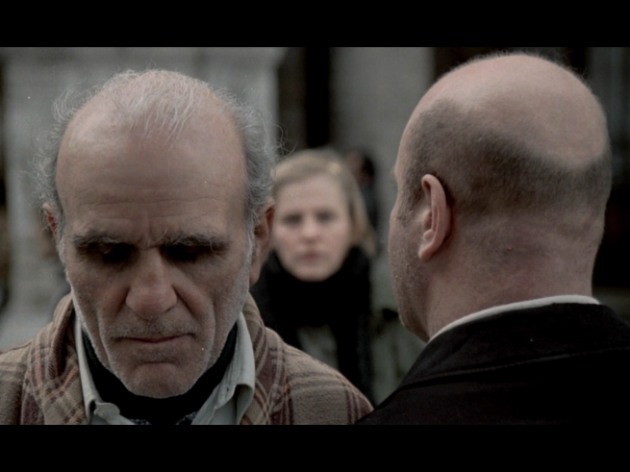
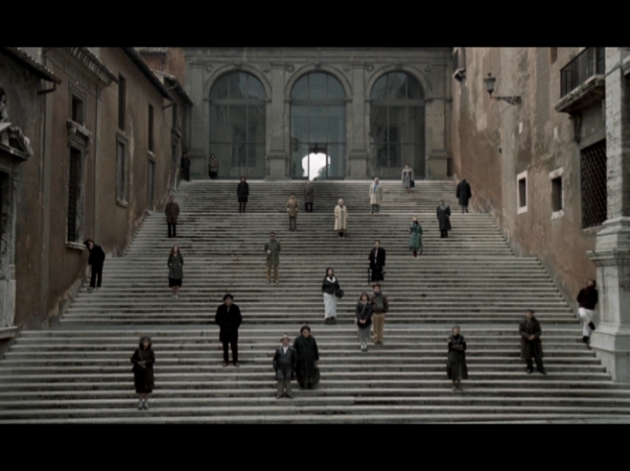
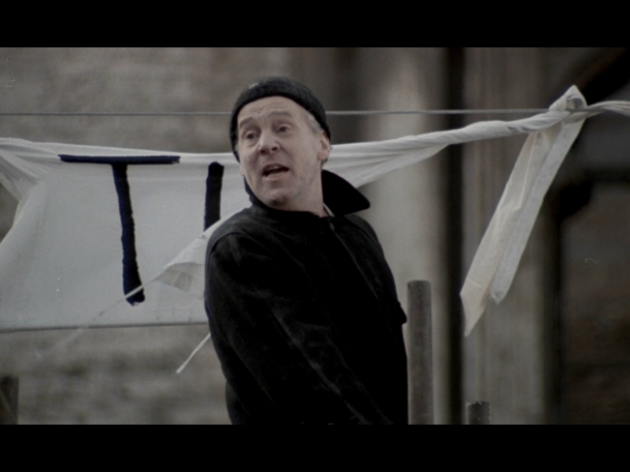
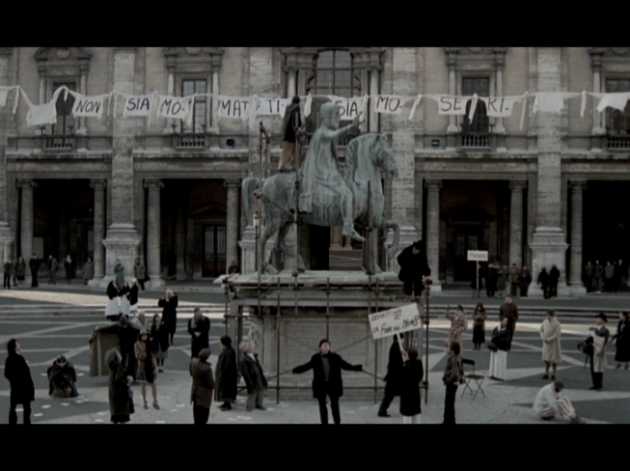
The first sequence of two that comprise Domenico’s monologue. Note the gradual disclosure of space and the micro-rhythmical contrast between close-up and long shot (upper two frames), and medium shot and long shot (lower two frames)
Figure 2
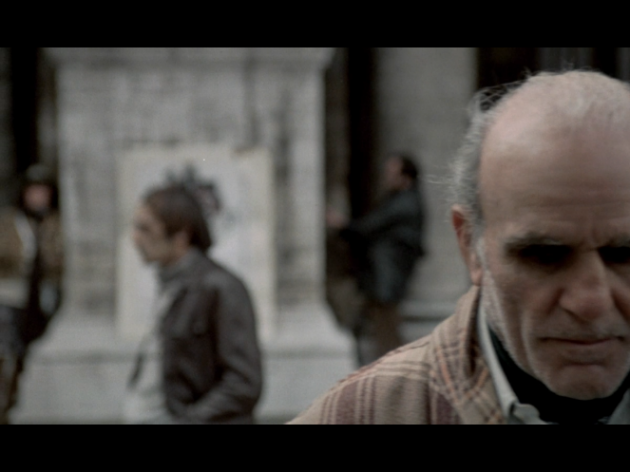
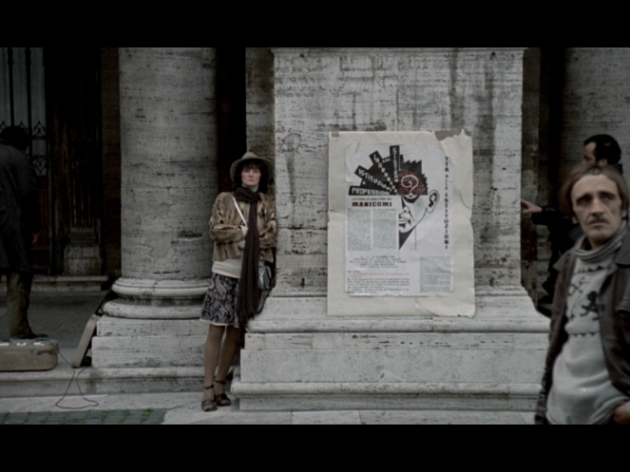
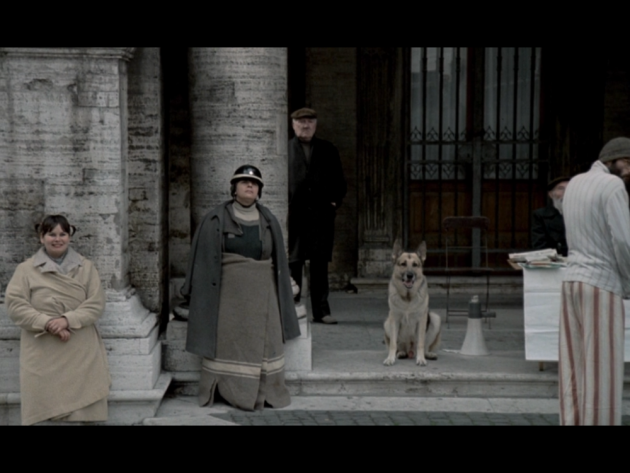
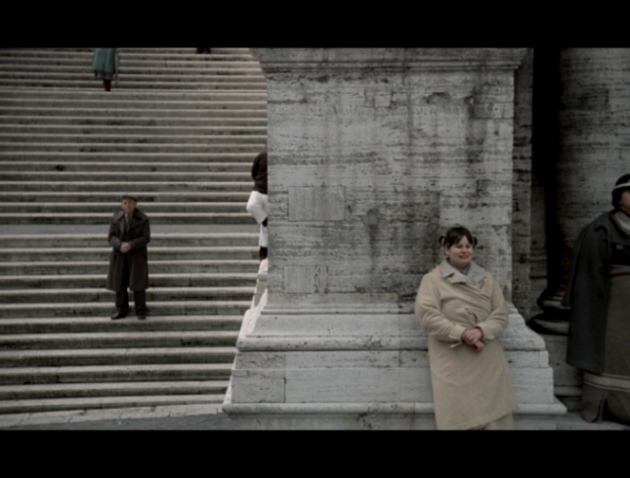
A progressive accentuation of affective intensities; the micro-rhythms within any-space-whatever
Figure 3
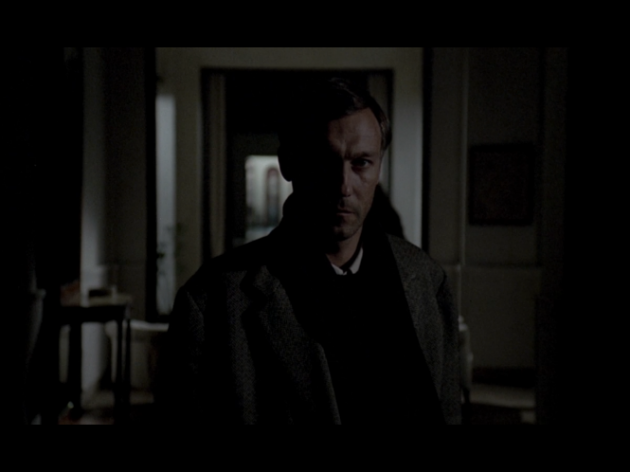
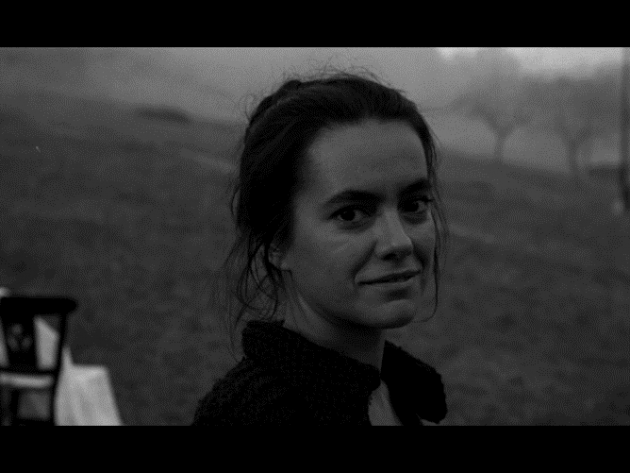
Gorchakov looking at any-space-whatever
Figure 4
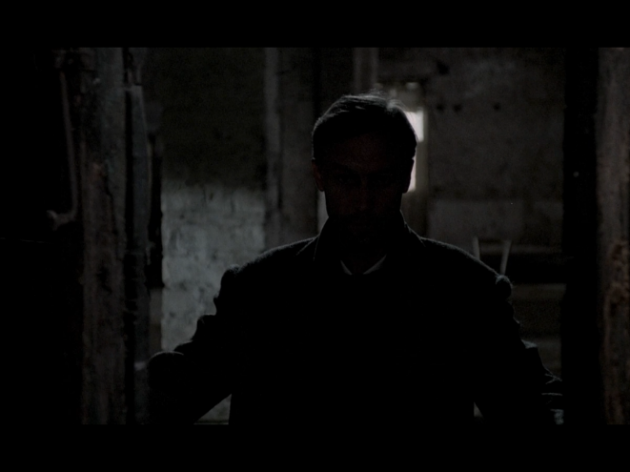
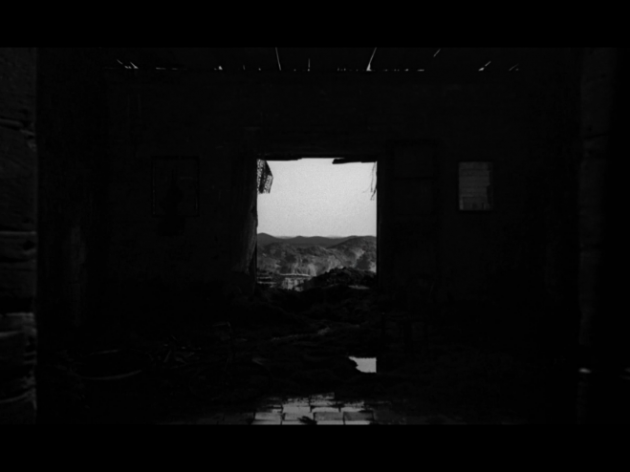
Gorchakov looking at an any-space-whatever that contains no human characters
Figure 5
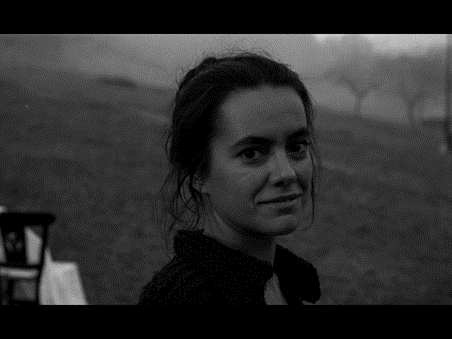
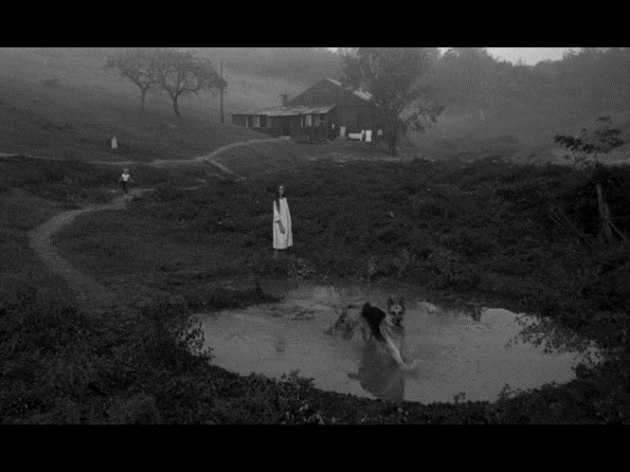
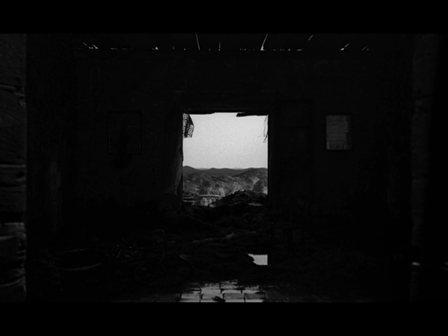
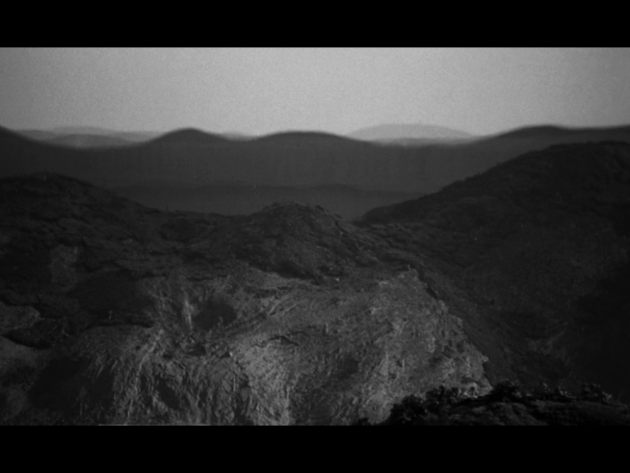
The rhythm of the dream-images exists in micro-rhythmical accents and contrasts that are distributed via slow movement and the position of the camera. At the end of the shot the scope is dissimilar, opposite even, to the scope the shot commenced with
Figure 6
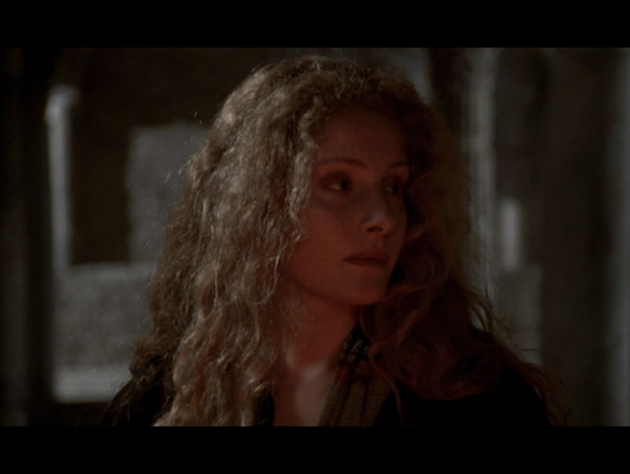
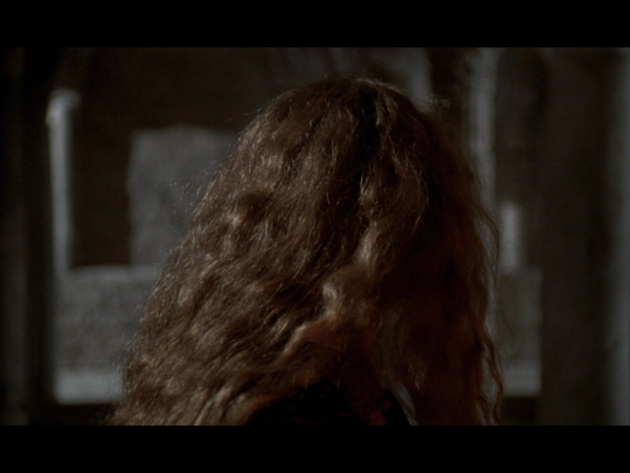
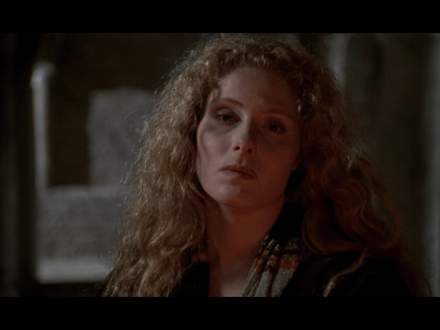
The rhythm of the any-face-whatever
Figure 7
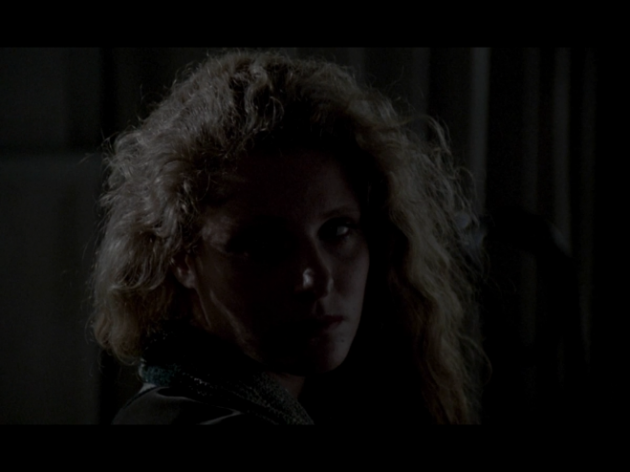
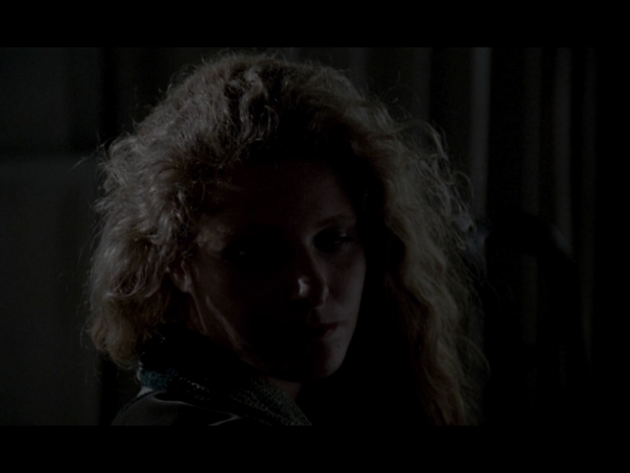
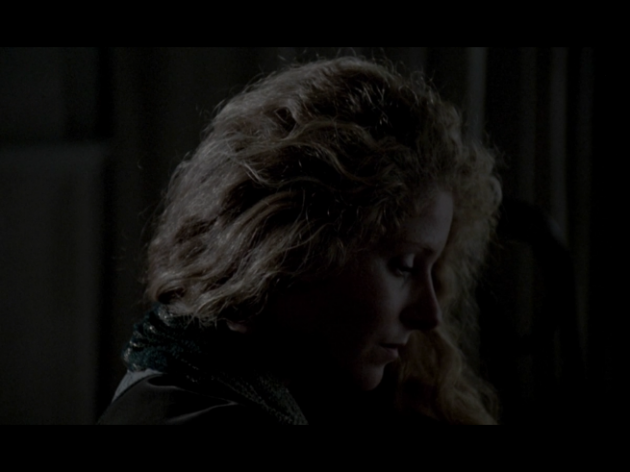
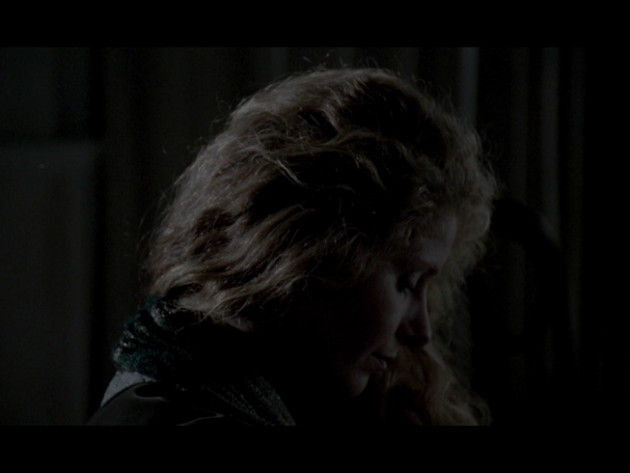
Eugenia in the hotel lobby
Figure 8
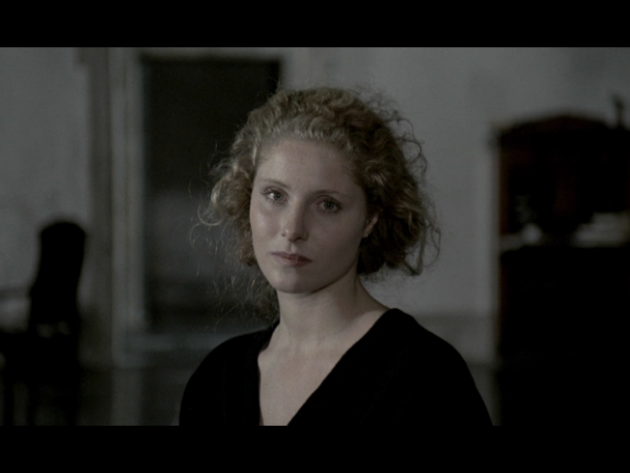
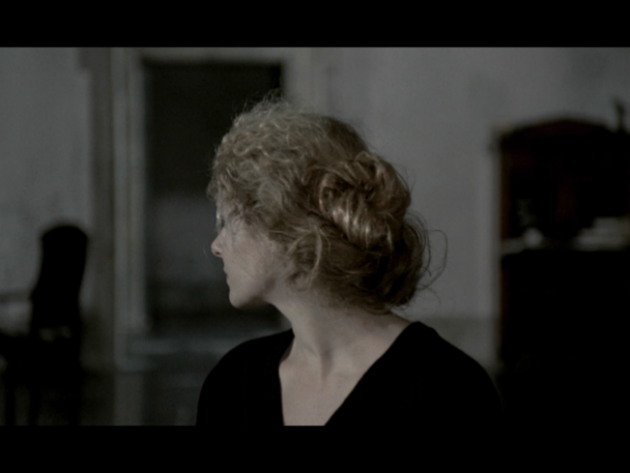
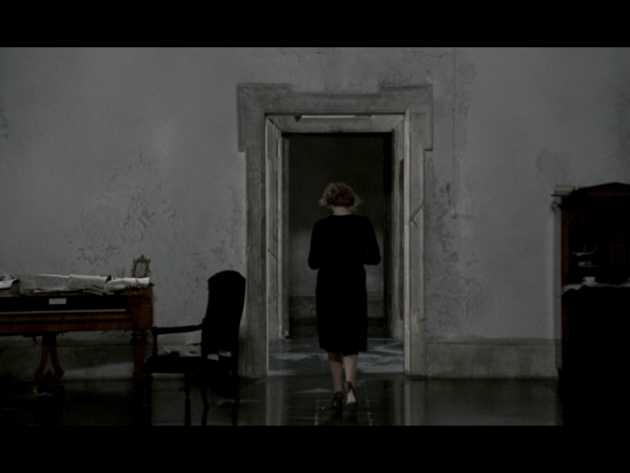
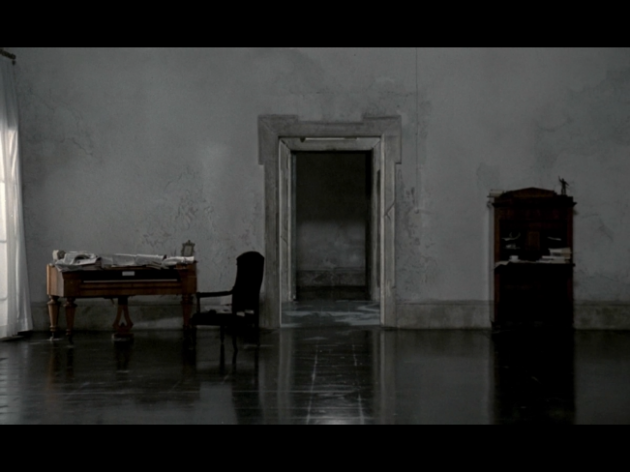
The any-face-whatever becoming any-body-whatever, slowly dissolving into a void
Balázs, Béla. Early Film Theory: Visible Man & The Spirit of Film. Ed. Erica Carter. Trans. Rodney Livingstone. Oxford: Berghahn Books, 2011.
Bogue, Ronald. ‘‘Musica Naturans: Deterritorializing the Refrain.’‘ Deleuze on Music, Painting, and the Arts. New York: Routledge, 2003. 13-31.
Burch, Noël. ‘‘Ozu Yasujiro.’’ To the Distant Observer: Form and Meaning in the Japanese Cinema. Berkeley: University of California Press, 1979. 154-185.
Chatman, Seymour. ‘‘The New Montage and Temps Mort.’’ Antonioni, or, The Surface of the World. Berkeley: University of California Press, 1985. 125-131.
Deleuze, Gilles. Cinema 1: The Movement-Image. Trans. Hugh Tomlinson and Barbara Habberjam. Minneapolis: University of Minnesota Press, 1997.
—-. Cinema 2: The Time-Image. Trans. Hugh Tomlinson and Robert Galeta. Minneapolis: University of Minnesota Press, 1997.
Kulezic-Wilson, Danijela. The Musicality of Narrative Film. EPUB. New York: Palgrave Macmillan, 2015.
Mitry, Jean. ‘‘Cinematic Rhythm.’’ The Aesthetics and Psychology of the Cinema. Trans. Christopher King. Bloomington: Indiana University Press, 2000. 104-149.
Perez, Gilberto. ‘‘The Deadly Space Between.’’ The Material Ghost: Films and their Medium. Baltimore: John Hopkins University Press, 1998. 123-148.
Seigworth, Gregory. J. & Melissa Gregg. ‘‘An Inventory of Shimmers.’’ The Affect Theory Reader. Eds. Melissa Gregg & Gregory J. Seigworth. Durham: Duke University Press, 2010. 1-25.
Tarkovsky, Andrey. Sculpting in Time. Trans. Kitty Hunter-Blair. Texas: University of Texas Press, 1989.
Vermeulen, Timotheus and Gry C. Rustad. ‘‘Watching television with Jacques Rancière: US ‘Quality Television’, Mad Men and the ‘late cut’.’’ Screen. 54:3 (2013): 1-15.
Internet sourcesJirousek, Charlotte. ‘‘Rhythm.’’ Art, Design and Visual Thinking. char.txa.cornell.edu. 1995. 12 January 2018. http://char.txa.cornell.edu/language/principl/rhythm/rhythm.htm
Sontag, Susan. ‘‘Against Interpretation.’’ shifter-magazine.com. 12 January 2018. http://shifter-magazine.com/wp-content/uploads/2015/10/Sontag-Against-Interpretation.pdf
FilmographyNostalghia. Dir. Andrei Tarkovsky. Opera Film Produzione, Rai 2, Sovinfilm, 1983. Blu-ray.
Notes
- Please note that the remainder of this paragraph is near identical to the introductory paragraph of my essay on the rhythm of any-space-whatever in Robert Bresson’s Lancelot du Lac, ‘The Any-Space-Whatever without Borders, Or Why Bresson Secretly Made Lancelot du Lac for People Who Can’t See’. (Documenta, tijdschrift voor theater. 35:2 (2017): 42-60.). Since both articles make use of the same theoretical framework and the same point of departure, and since the genesis of both articles can be found in my master thesis, the same applies to the second paragraph (on rhythm) and the closing comments. The corpus of this article (paragraphs 3, 4 and 5) is a significantly revised version of the fourth chapter of my master thesis, which can be accessed through the Radboud University Repository here: http://theses.ubn.ru.nl/handle/123456789/2643. ↩
- In a metaphorical-Foucauldian sense . ↩
- Kulezic-Wilson, on her turn, borrows these terms from Léon Moussinac (1925/1978, pp. 94-9). ↩
- Again, these terms come from Kulezic Wilson 65-66. ↩
- Personally though, I would prefer the less aggressive term ‘sensuality’. ↩
- Bogue exemplifies Deleuze and Guattari’s writings on territorial motifs in animal rituals and in music (A Thousand Plateaus 318-319). Not a cinematic term by origin, but it can very easily be transposed to film, I believe. ↩
- The copyright and ownership of all the images featured in this appendix belongs to Rai Cinema. ↩



